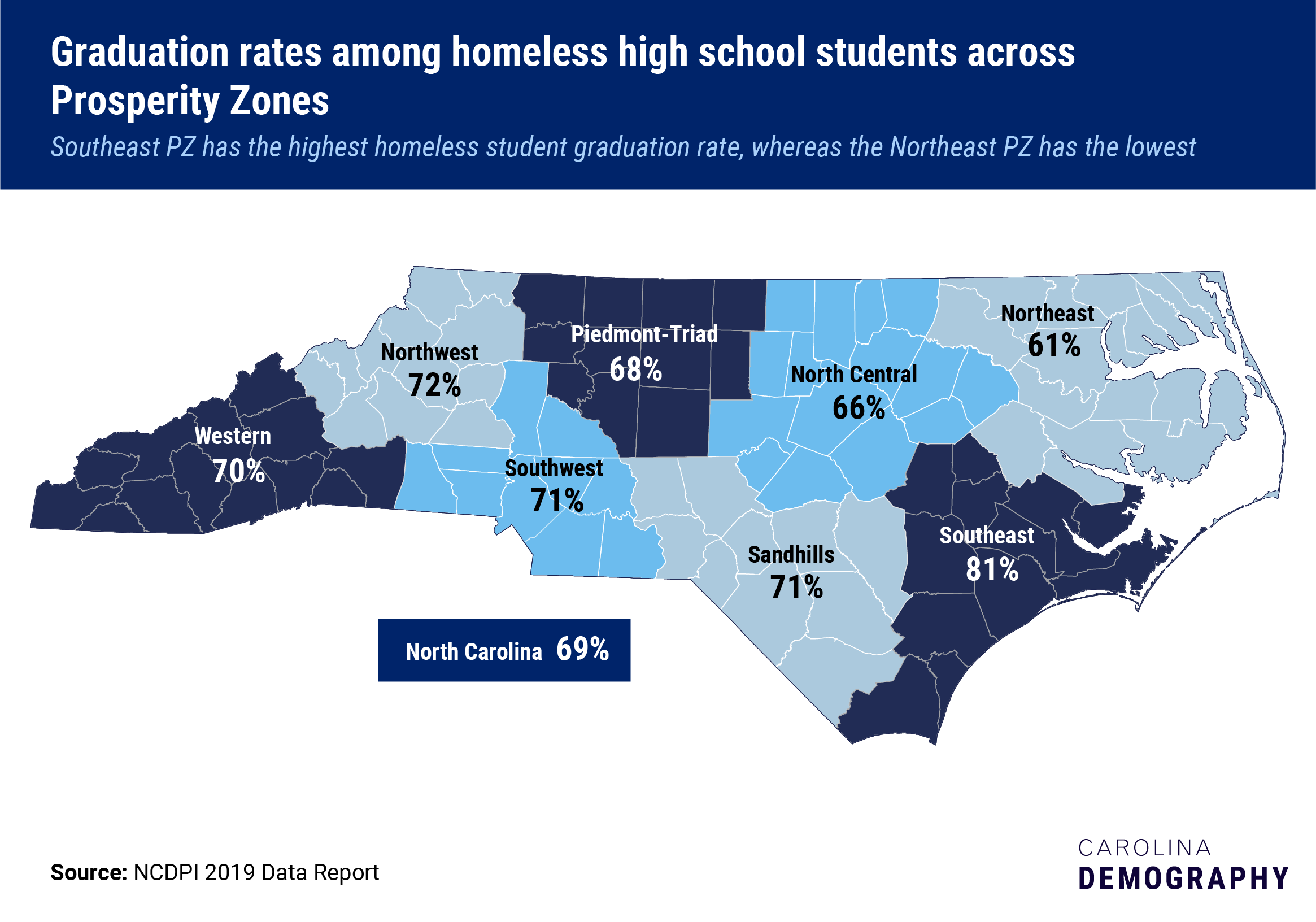How many students graduating high school in NC are homeless?

A report published last month by the National Center for Homeless Education at UNC-Greensboro indicated that the population of homeless students enrolled in public school districts has increased 15 percent in the last three years and now numbers 1,508,265 youth, the highest in more than a decade.
In North Carolina, there are an estimated 26,361 public school students who experienced homelessness over the course of the 2016-17 school year, according to the United States Interagency on Homelessness. College students are also not immune: a recent student survey administered at NC State found that almost 10% of their student body had experienced homelessness in the past year.
The federal definition of homelessness includes those who lack a “fixed, regular, and adequate nighttime residence.” This includes individuals and families who are living with others due to a loss of housing, often referred to as “doubling up.” Additionally, individuals living in shelters, motels, hotels, trailer parks or campgrounds in the absence of other consistent housing options may also be considered homeless. Of the 26,361 homeless public school students in North Carolina, 1,163 were unsheltered, 2,667 lived in shelters, 3,565 lived in hotels or motels, and 19,131 were doubled up.

These numbers reflect students along the entire K-12 continuum. We looked at the prevalence of homeless students in the state at a critical point along the education continuum—high school graduation. Using the NC Department of Public Instruction (DPI)’s 2019 School Assessment and Other Indicator Data report, we calculated the size of the homeless student population graduating from high school in NC.
We’re focusing on this group for a few reasons. Earning a high school diploma is associated with general economic, social, and health benefits and is a necessary step in the transition to either college or gainful employment. Student homelessness, in contrast, is associated with lower school achievement and increased risk of dropping out of school. Homelessness is a particularly salient issue among those students approaching high school graduation, as national data have shown that the percentage of homeless 12th graders grew by 22.9% from the 2015-16 school year to 2017-18—the largest increase among all grade levels measured.
Homelessness and high school graduation in North Carolina
At the national level, data from the 2016-17 school year reveals that 4-year graduation rates among homeless students range from 45% to 88%, with a national average of 64%. In North Carolina, 87% of 9th graders completed high school within four years. In comparison, only 69% of students identified as “homeless” graduated within four years, five percentage points higher than the national average for this student group. Among student subgroups that reported by DPI collects data on, homeless students have one of the lowest four-year high school graduation rates: economically disadvantaged students (82%), students with disabilities (70%), migrant students (73%), English language learners (71%) and all racial/ethnic subgroups (ranging from 94% to 81%) are all higher. The only subgroup with a lower graduation rate was students in foster care, with 58%.

Warren County had the lowest graduation rate (50%), followed by Durham (52%), Alamance (53%), Davidson (54%), and Pitt (55%). The counties with the highest graduation rates for homeless children were Surry, Bladen, Pender, Cherokee, and Jackson (all with 95%). North Carolina, on average, graduated 69% of homeless children. The Northeast Prosperity Zone had the lowest graduation rate for homeless children (61%) while the Southeast Prosperity Zone had the highest (81%).

What is NC doing to combat the problem?
Given the statistics, how does NC help homeless students, particularly those approaching graduation? In December 2015, the Every Student Succeeds Act (ESSA) reauthorized the McKinney-Vento Education for Homeless Children and Youth (EHCY) Program. Although the EHCY program existed prior to the authorization in 2015 of ESSA, ESSA strengthened and improved the program.
The McKinney-Vento Act provides protections for homeless youth, ensuring their ability to attend school, as well as addressing issues such as access and privacy. Specifically, educational agencies must ensure that homeless children have equal access to the same free, appropriate public education as other children, as well as related academic services. In addition, the EHCY program ensures that student records are kept private, including information regarding the child’s living situation. Local liaisons implement the EHCY program by identifying homeless children and youth, and among other things, linking them resources including preschool and health services. In addition, the EHCY program requires school district homeless liaisons to guarantee that unaccompanied homeless youth are informed of their status as independent students for the FAFSA and receive assistance to verify their homelessness.
This allows these students to be considered “independent” for the purposes of financial aid eligibility and circumvent the need to provide parent’s financial information. The North Carolina Homeless Education Program, administered by the SERVE Center at UNC Greensboro, works to guarantee NC state policies comply with federal law. For more information, visit their site.
Need help understanding population change and its impacts on your community or business? Carolina Demography offers demographic research tailored to your needs.
Contact us today for a free initial consultation.
Contact UsCategories: Education, NC in Focus

The Center for Women’s Health Research (CWHR) at the University of North Carolina School of Medicine released the 12th edition of our North Carolina Women’s Health Report Card on May 9, 2022. This document is a progress report on the…

Dr. Krista Perreira is a health economist who studies disparities in health, education, and economic well-being. In collaboration with the Urban Institute, she recently co-led a study funded by the Kate B. Reynolds Foundation to study barriers to access to…

Our material helped the NC Local News Lab Fund better understand and then prioritize their funding to better serve existing and future grant recipients in North Carolina. The North Carolina Local News Lab Fund was established in 2017 to strengthen…
Your support is critical to our mission of measuring, understanding, and predicting population change and its impact. Donate to Carolina Demography today.